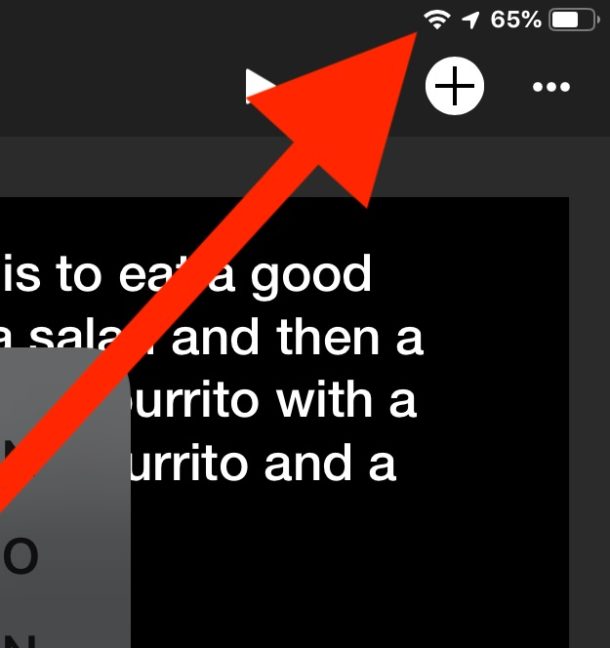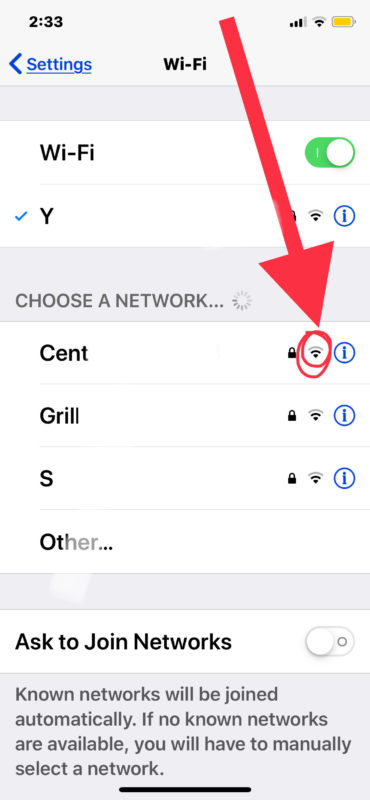How to View Wi-Fi Networks Signal Strength on iPhone or iPad

Want to see a wireless networks wi-fi signal strength from an iPhone or iPad? That’s easy enough, and you have two quick and simple ways to view the wi-fi signal strength of a currently active wireless network right from iOS, and you can even see the signal strength of other nearby networks too.
The first option is fairly obvious and that’s in the device status bar at the top of an iOS device screen, that will show you the currently connected and active wi-fi signal strength. The second option is through the iOS Settings app and can show you not only the currently connected wireless networks wi-fi signal, but also other nearby networks wi-fi signal strength too.
How to Check Current Wi-Fi Networks Signal Strength in iOS
As mentioned, the currently active Wi-Fi signal strength is always shown in the upmost status bar of an iPhone or iPad, and that can be the first place you look if you want to check the signal of an active current wireless connection from an iOS device.

Three bars is a good signal, two bars is OK, and one bar is generally a pretty weak or bad wi-fi signal that may even have trouble sending and receiving data.
How to View Other Wi-Fi Networks Signal Strength in iOS
Additionally, you can also check wi-fi signal strength of other nearby wifi networks directly from the Settings app:
- Open the “Settings” app on iPhone or iPad
- Go to “Wi-Fi”
- Under the Wi-Fi network list, locate the name of the wi-fi network or wireless router you want to check the signal strength for
- Look alongside the wi-fi network name for the little wi-fi signal indicator, which can be generalized as so:
- Three bars – Good wi-fi signal
- Two bars – OK wi-fi signal
- One bar – weak wi-fi signal

There can be many reasons why a wi-fi signal may be good or bad, but the two main factors for wi-fi signal strength are generally distance from the access point, and signal interference. For most situations, the closer you are to the wi-fi router or access point, the stronger the signal. Similarly, the less interference the better the signal. Some types of walls and other metals and machinery can also impact a wireless signal.
The good news is that because you’re checking the wi-fi signal on an iPhone or iPad, the device itself is very mobile and so often simply moving around or moving the device can make the difference between signal strength.
Checking wi-fi signal strength in iOS is pretty easy, but if you’re an advanced user or a network administrator you might find this simple method to be insufficient. There are various wi-fi tools for iOS however that can be helpful to check out, for example the Fing network scanner tool for iOS is pretty good, though generally you’ll find that the iOS based tools are not nearly as robust as comparable options are on the Mac, Linux, or Windows desktops, let alone with the Mac Wi-Fi Diagnostics wireless tool or airport command line tool.
If you know of any other handy tips or tricks for monitoring wi-fi signal strength and connections on iPhone or iPad, share in the comments!


What I will describe here, is related to the iPhones and other Apple phones and pads that allow you to find WI-FI signal strength. A weak signal will result in slow internet speeds, regardless of services you have purchased from
tv and internet providers.
The year is 2020. It’s August. If you open up your iPhone phone app and dial *3001#12345#* and push the call button, you will go to a screen titled field test. There are several possible selections on the field test screen. Select the serving cell measurements selection and you will open up another page which shows on the top the RSSI signal and it should be a negative decibel level of between -50 dbm to -130 dbm. Any dbm rating of -90 or higher will be unacceptable signal strength for Wi-Fi. If you have a dbm rating of -90 or greater, meaning up to -130 dbm is because the router you are provided for Wi-Fi is inadequate to acceptably operate Wi-Fi items such as Wi-Fi computers, or cell phones, or streaming video and television items, such as Roku streaming sticks or Roku box set ups, as well as Netflix, Hulu, prime video, fubo TV, or YouTube.
Routers/Gateways are the primary system units for TV & Internet service boxes from ATT, Infinity, Spectrum, Comcast and many other service providers across the USA.
Andoid phones, Windows and Mac pc’s also have this type of Utilities. It’s not necessary to download 3rd party apps or software, and are far more accurate and detailed.
This signal strength problem is virtually always due to your router/gateway.
Be advised, unstable or weak signal strength, results in providers highly recommending “faster” services at elevated prices instead of actually providing quality equipment.
You are welcome!
Field test mode is for cellular signal and cellular connection, not wi-fi. But yes it is very useful to determine how strong or weak a cellular signal is.
You are describing the range between -90 and -130 as “-90 or greater,” however the numbers from -91 to -130 are all less than -90, so you should describe this range as “-90 or less.”
It’s the iPhone. I have a 1.3ghz card in a new pc in basement with an M.3 drive (as fast as ram) and it opens a browser and connects in about 1/5th of a second. My iPhone which is supposedly an 802.11AC connection also about 1.3ghz, takes about 1-2 full seconds to open chrome and connect.
Even an iPhone 6 has a cpu fast enough to open s browser in 1/100th of a second, so there is a major defect in the iOS. Since their only legit leader that held their lazy inept management to a standard is now dead, don’t expect much improvement.
If it’s at 3 bars why is my phone still slow then ?
Does anyone know how to access the app settings? Because I dont have an air port I can only click internet and get basic ip connection info but there are no settings at all.
This is not much use. Anyone in an urban setting is surrounded by an ever growing number of WiFI devices. I get at least 10 viable WiFi signals in my living roomWhy not adopt some of the very good apps from Android like WiFi Analyzer??? i have to kidnap my kids ONE plus to troubleshoot WiFi. Btw I-Pad and I-Phone have average to inferior radio so help would be useful
I can’t believe IOS don’t have an app like Android like WiFi Analyzer. It was fantastic with so much information!! I can’t believe I would be wising for my old Blackberry to come back again!!
IOS App Developers really….. come on please….
I am new to Apple. I was looking for a wifi and cell sig strength meter and I couldn’t find anything even close. A bunch of silly apps as apparently the only criteria Apple users need are speed numbers.
One could also use Apple’s “AirPort Utility” app and enable “Wi-Fi Scanner” from the app settings. That offers the AP signal strength in dBmV, including those that do not broadcast SSID, and scans them over a user-defined period so it offers multiple readings over time.
Unfortunately the “AirPort Utility” app does not have any settings, therefore it is not possible to enable “Wi-Fi Scanner” from the app settings.
Fortunately the Airport Utility is consistent with IOS standards.
Its settings can be found in the Settings App.
Well this is cool, guess I never really thought to use this as a wi-fi signal strength indicator.
I mean it’s obvious, but it’s also not at all. Cool tip thank you.